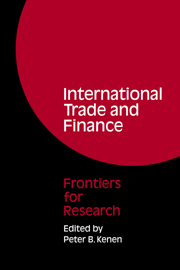Book contents
- Frontmatter
- Contents
- List of Contributors
- Preface
- PART I TRADE, PROTECTION, AND DOMESTIC PRODUCTION
- PART II ECONOMETRIC MODELS OF TRADE AND PAYMENTS
- Price, Incomes, and Foreign Trade
- The Multinational Corporation and Direct Investment
- Empirical Research on Financial Capital Flows
- Discussion
- Part III PAYMENTS ADJUSTMENT AND THE MONETARY SYSTEM
- PART IV AN OVERVIEW AND AGENDA
- Glossary of Frequently Used Acronyms
- Author Index
Discussion
Published online by Cambridge University Press: 05 November 2011
- Frontmatter
- Contents
- List of Contributors
- Preface
- PART I TRADE, PROTECTION, AND DOMESTIC PRODUCTION
- PART II ECONOMETRIC MODELS OF TRADE AND PAYMENTS
- Price, Incomes, and Foreign Trade
- The Multinational Corporation and Direct Investment
- Empirical Research on Financial Capital Flows
- Discussion
- Part III PAYMENTS ADJUSTMENT AND THE MONETARY SYSTEM
- PART IV AN OVERVIEW AND AGENDA
- Glossary of Frequently Used Acronyms
- Author Index
Summary
PRICES, INCOMES, AND FOREIGN TRADE: A COMMENT
My comments will focus on Magee's paper and, in particular, on areas that Magee points out explicitly or in passing as needing further research. In general, his suggestions can be summarized as a need for more complete models. I agree with him. However, I should like to elaborate on a few of his points as well as raise some others, all within the context of world trade modeling. In addition to their usefulness in forecasting, we are interested in world trade models in order to investigate questions such as the effect on trade balances – and some day, on the balance of payments – of domestic and international price changes, income developments, and exchange-rate adjustments.
One area that could profit from further theoretical and empirical research is the import behavior of less developed countries, mentioned by Magee in footnote 1. In world trade models, these countries are often treated as one or a small number of groups, frequently by continent. In some empirical work, foreign exchange availability is used as a proxy for economic activity for imports by less developed countries. In other instances, foreign exchange availability has a different meaning. Rhomberg-Boissonneault (1964) treated all less developed countries as one group (that group also included Canada, Japan, Australia, New Zealand, and South Africa) and set the value of their imports as equal to current foreign-exchange earnings, specifically exports plus net capital inflows less changes in reserves.
- Type
- Chapter
- Information
- International Trade and FinanceFrontiers for Research, pp. 363 - 376Publisher: Cambridge University PressPrint publication year: 1976



